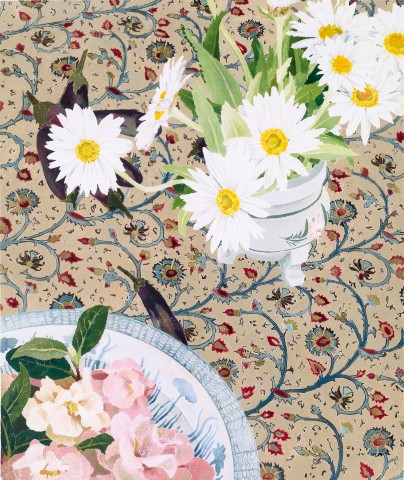DAISIES AND CAMELLIAS ON INDIAN CLOTH, 1997
CRESSIDA CAMPBELL
unique colour woodblock print
61.0 x 52.0 cm
signed below image lower right: Cressida Campbell
Philip Bacon Galleries, Brisbane (label attached verso)
Private collection, New South Wales
Estate of the above, New South Wales
Cressida Campbell, Philip Bacon Galleries, Brisbane, 14 October – 8 November 1997, cat. 25 (as ‘Daisies & Camelias on Indian Cloth’)
Crayford, P., (ed.), The Woodblock Painting of Cressida Campbell, Public Pictures Pty Ltd, Sydney, 2008, cat. P9703, p. 345
Daisies and Camellias on Indian Cloth, 1997, watercolour on incised woodblock, 61.0 x 52.0 cm, illus. in Crayford, P., (ed.), op cit., cat. W9712, p. 87
Cressida Campbell is an artist who clearly takes great personal delight in the act of looking. The detail, careful composition and colouring of her artworks provide in turn ample stimulation for the viewer to continue this pleasurable process long after the object has left the artist’s studio. Campbell’s works are sublime. They do not aim to shock or admonish viewers, nor do they operate as vehicles for socio-political commentary. Campbell takes her cues from the rich visual delights of her immediate environment, from the lush bushlands around Sydney harbour to the patterns of shadows on her kitchen floor. Campbell captures the form and colour of everyday objects, translating them into artworks that express with enduring appeal the quiet tranquillity of her surrounds.
The decorative combination of flower arrangements and patterned fabrics collected during the artist’s travels has appeared in many of Campbell’s most successful works, including Nasturtiums, 2002, Bougainvillea, 2003 and Ranunculus with Painted Cloth, 2010. Daisies and Camellias on Indian Cloth, created in 1996, is amongst these, also revealing the artist’s signature precision and prettiness. Closely cropped, this domestic still life depicts pink camellia blossoms placed in a bowl and fresh daisies stretching joyfully across a tablecloth, its dense paisley pattern concealing finger eggplants casually strewn across the table in preparation for a meal. Almost all of Campbell’s still lives are semi-autobiographical, displaying in their subject matter and aesthetic structure cultural crossovers indicative of the artist’s own eclectic and multicultural interests. In this composition, a Malaysian Nonyaware porcelain bowl is filled with blossoms, placed on a Mughal paisley block-printed cloth, together arranged in a scene designed following Japanese principles of woodblock printing.
The related woodblock of Daisies and Camellias on Indian Cloth was exhibited in a group exhibition called Still Lives, at Rex Irwin Art Dealer in November 1996, a full year before its unique print was exhibited and purchased from Philip Bacon Galleries in Brisbane. The block was singled out as a work of distinction at the time by John McDonald and used to illustrate his review of the exhibition in the Sydney Morning Herald.1 What lifts Campbell’s work beyond the realm of simple observation and representation, are slight artistic conceits she introduces within her choice of colour, texture and asymmetrical compositions. Campbell further incorporates sensuous elements in the chalky, bleached colour of the watercolour prints, and the mottled texture left behind on the block after the single print has been pulled.
The long and illustrious history of the genre of Still Life has often been entangled with powerful moral lessons about the emptiness of worldly possessions, and memento mori – the fleeting nature of natural beauty and the transience of earthly life. If these classic codes of iconography inform our contemporary reading of Campbell’s work, this is unintentional. Memorialising opportunistic everyday details from her domestic environment and elevating them to the hallowed surfaces of her compositions, Campbell makes no comment on distinctions between fine art and decoration, simply addressing the things in which she derives an aesthetic pleasure and hoping that others will respond in turn to their seductive impact.
1. McDonald, J., ‘Still Lives’, Spectrum Arts, Sydney Morning Herald, Sydney, 16 November 1996, p. 16
LUCIE REEVES-SMITH
